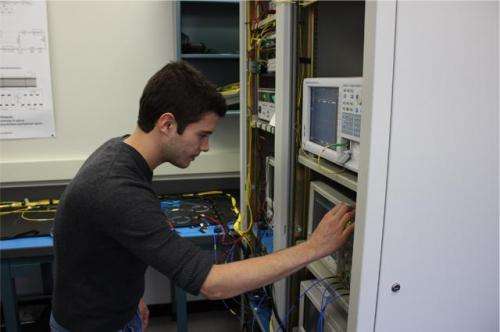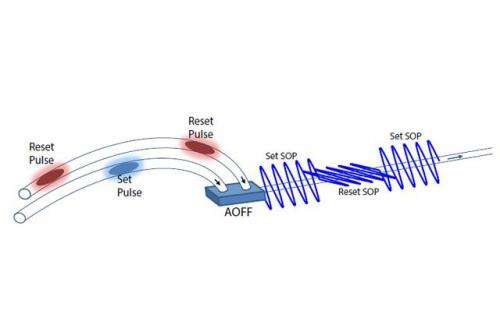Researchers increase the switching contrast of an all-optical flip-flop

Researchers at the Rochester Institute of Technology in New York have increased the switching contrast of a particular kind of all-optical flip-flop by 28 dB, resulting in a switching contrast of 36.6 dB. This could provide a huge leap in the performances of a range of photonic techniques, such as all-optical packet switching, all-optical label addressing, and square-wave clock generation, as well as other photonic devices housing semiconductor optical amplifiers or even passive nonlinear media.
Speeding up
All-optical flip-flops provide a means of sequential signal processing – as opposed to combinational signal processing – in the optical domain. The sequential-processing nature of all-optical flip-flops provides a latchable control signal for devices based on combinational processing. Drew Maywar, one of the authors of the Letter, told us that "advances in optical-packet switching performed at the University of Ghent, the University of Tokyo, and Eindhoven University of Technology, for example, use optical flip-flops to drive data-wavelength converters to achieve wavelength routing of optical packets."
However, Maywar explained, the switching performance of some previous optical flip-flops is poor – control signals operate with only specific polarisation states, over a narrow wavelength range of operation, or with high optical power. "The cycle switching time of some flip-flops is longer than 1 ns," he said, "which is not ideal for some applications, and the switching contrast is also poor ( <� 10 dB) for some demonstrated flip-flops."

Latching on
In order to realize their 28 dB contrast enhancement, the team exploited two disparate physical processes within a resonant-type nonlinear medium: optical dispersive bistability and nonlinear polarisation rotation. The resulting bistable polarisation rotation (BPR), in conjunction with a linear polariser, then led to the increased switching contrast.
In essence, Maywar explained, the team have realised a latchable polarisation switch: "whereas the traditional polarisation switch (or Kerr shutter) is a combinational device, acting only when on present control signals, our device is sequential, exhibiting memory of past control pulses, and these two polarisation states can be switched back and forth by control signals whose polarisation states are themselves arbitrary."
Another interesting aspect of the enhancement of the switching contrast is that it outperformed the standard method for measuring the contrast. For switching contrasts around 5 dB (the previous standard), a photodiode and oscilloscope were sufficient but, as the contrast improved, this technique set a false upper bound of around 15 dB. "After some tinkering and reflection," explained Maywar, "it was realised that a more sensitive diagnostic was needed, which provided a nice, educational-enriching hurdle that challenged the students' notions of the actual signal vs the measured signal."
Small and nimble
Maywar expects their work to be easily extended to other resonators, such as loops, rings, distributed feedback structures, and vertical cavities, and to other nonlinear media, such as passive InP and SiO 2. Furthermore, enhanced-contrast flip-flops are building blocks and he hopes to make use of such devices in larger functional photonic subsystems.
This integration would be achieved through the miniaturisation of the team's all-optical flip-flops. "Such an effort is expected to increase the cycle-switching time, and lower energy consumption and heat dissipation," said Maywar "and this work is aligned with our team's wider research goals of developing photonic devices and demonstrating optical-switching applications."
Looking to the future, Maywar told us that he thinks research in all-optical flip-flops will continue to improve switching performance and attack the major issues of drive power (energy consumption and heat dissipation), and device size: "I would like to see demonstration of miniaturised all-optical flip-flops, at least 100 times smaller than the millimetre-length devices used in present-day demonstrations. As such, nanophotonics may provide a path forward in keeping control-signal power reasonable with such small, nonlinear components."
More information: "All-optical flip-flop contrast enhancement based on bistable polarisation rotation within Fabry–Perót SOA." Electronics Letters, Volume 50, Issue 22, 23 October 2014, p. 1620 – 1622 DOI: 10.1049/el.2014.3002
Journal information: Electronics Letters
Provided by Institution of Engineering and Technology
This story is published courtesy of Electronics Letters. For additional Electronics Letters news and features visit theiet.org/eletters.





















